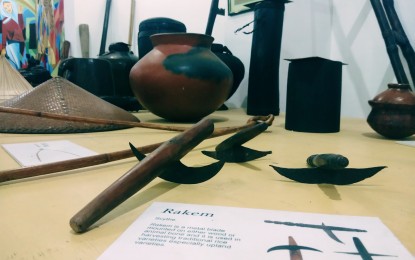
RICE MUSEUM.Some of the farm implements on display at the rice museum in Batac City, Ilocos Norte. (File photo)
LAOAG CITY—The mecca of rice in Ilocos Norte has been attracting farmers and students.
Ten-year-old Gian Abad, a Grade V pupil of Shamrock Elementary School in Laoag City was asked what the tools to harvest rice are and he may stare at you with a blank look on his face.
As a city boy, he regularly consumes rice at least three times a day but may not have been to the rice fields nor witnessed what it was like to be planting or harvesting rice under the scorching heat of the sun.
"A trip to the rice museum for the first time enabled him to see a plow and harrow, singkaw (yoke), and tsako among others which were used by farmers in the old times."
With the continuing farm modernization, the Philippine Rice Research Institute (PhilRice) in Batac City established a rice museum where young learners can appreciate the culture of this staple food for Filipinos.
The rice museum located at the lower ground floor of PhilRice building is the first of its kind rice museum in the province that houses rice-based farming systems, involving pieces of material culture, from the past and present and highlights the culture of rice farmers in the country.
It also features different information and technologies in rice production with audio visual presentation.
Specifically, the centerpiece of the museum is the Ifugao rice culture, which is described as the best representation of rice culture in the country with its backdrop of the rice terraces and farm tools and equipment, like the batawel (for carrying the harvest), galud (for digging), panuptop (taking down soil from the terraces), hukikud (dibbles), ganulang (for harvesting), luhung and lalu (mortar and pestle), and heirloom rice harvests, among others.
The museum also has sections for lowland farming that shows plow and harrow, singkaw (yoke), and tsako among others; modern farming, biodiversity that depicts the diverse life forms in the rice fields, anatomy of rice kernel, rice ecosystem, rice art, rice food, rice life, rice environment, and rice technologies, among others.
Dr. Reynaldo C. Castro, Chief Science Research Specialist of PhilRice-Batac, said Friday that hundreds of farmers and students had visited the museum for learning. “
The rice museum aims to show the importance of rice to Filipinos.
The collected artifacts and farm implements, Castro said, present the evolution of rice technology over the last 2,000 years.
Castro said the rice museum is open to all interested groups and individuals from Mondays to Fridays to promote a deeper appreciation of what agriculture means as the backbone of the economy.
In a study, Filipino farmers are aging with 58 years old as the average in Ilocos Norte.
It is in this premise that local government units, research agencies and other support groups are enticing the young to engage themselves in all aspects of agriculture to produce a new wave of farmers who can help sustain growth and development. (PNA)
